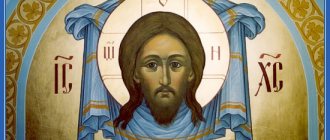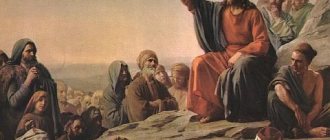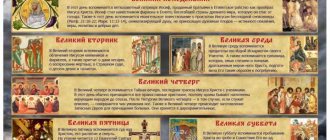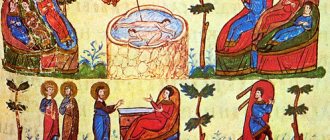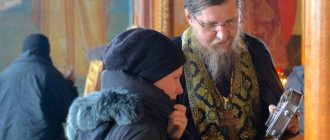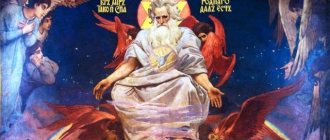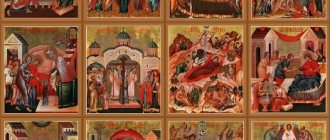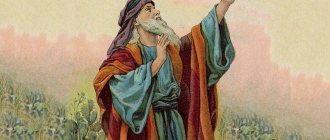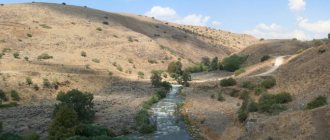The Presentation of the Lord - what kind of holiday is it?
The Slavic word “sretenie” is translated into modern Russian as “meeting”.
What is the essence of the holiday?
Meeting is a meeting of humanity in the person of Elder Simeon with God.
The essence of Candlemas is that this biblical event symbolizes the meeting of the Old and New Testaments.
“In the person of Simeon, the entire Old Testament, unredeemed humanity, departs in peace into eternity, giving way to Christianity...”
Bishop Theophan the Recluse
How does an image help?
The Most Holy Icon in honor of the Meeting, that is, the meeting of the Son of God with the righteous Simeon, is a symbol of the coming of a new order and the salvation of the entire human race. The New Testament corresponds to the Old Testament. Jesus, the Son of the Most High, came to our world in the form of a man to give people Christian teaching. Believers can pray to the icon and thank God for this knowledge.
Simeon, having met Christ, soon went to hell to announce to the souls of the martyrs gathered there about imminent liberation and salvation. Indeed, thanks to the sacrifice of the Son of God, all sinners received forgiveness. Jesus cleansed the whole world from sin.
The Savior gave people teaching, thanks to which the pagans converted to Christians and received the grace of God; Christ opened mankind’s eyes to the truth.
The Son of God gave people the truth, taught them how to live, what to do in order to receive the grace of God during life and after death, in order to enter the Kingdom of Heaven. Christians can pray to the image and ask God to free the mind and sanctify the soul with the purity of Christian teaching.
The image entitled “Introduction of the Lord” helps believers strengthen their faith and receive the protection of the Lord. Prayers to Jesus save people from illnesses, problems, hunger, and misfortunes. Believers ask the Holy Son of God to protect them from visible and invisible enemies, to help them in a hopeless situation.
The Presentation of the Lord icon helps:
- strengthen faith in Christ;
- ask God for forgiveness for your sins;
- soften the wrath of God;
- receive salvation from illnesses, misfortunes, enemies;
- find a way out of a difficult situation;
- to regain serenity after the loss or death of a relative or friend.
When a person has a heavy heart, he comes to the temple of the Lord and reads prayers in front of his holy image. The believer entrusts all his secrets to God and asks Christ for forgiveness of sins. Having sincerely repented of sins, a Christian has the right to hope for God's mercy and mercy.
The Savior is merciful. Christ forgives the sins of many people, but severely punishes some. Believers must accept God's will, whatever it may be. The Lord can send a person to severe trials.
Sincere prayer before the image of the Presentation of the Lord will help the believer overcome all the difficulties he has encountered. Christians must remember that they will answer for their sins before God.
Meeting - the history and essence of the holiday
After reading a brief history of the Presentation , you will easily recognize all five characters depicted on the icon.
Simeon the God-Receiver was a righteous and pious man. According to legend, King Ptolemy II Philadelphus commissioned him to translate the Holy Scriptures from Hebrew into Greek. When Saint Simeon was translating the book of the prophet Isaiah and read the words:
“Behold, the Virgin will be with child and give birth to a Son,”
he considered the word “Virgin” to be a mistake and was about to correct it to the word “Wife” . But the angel stopped the hand of Saint Simeon and promised that he would not die until he was convinced of the truth of the prophecy .
According to legend, Elder Simeon lived ~300 years . One day, at the call of the Holy Spirit, he appeared in the temple at the very moment when Mary and Joseph brought the Baby Jesus .
Simeon took Him in his arms and, praising God, said:
Now do You let Your servant go, Master, according to Your word, in peace, for my eyes have seen Your salvation, which You have prepared before the face of all nations, a light to enlighten the Gentiles and the glory of Your people Israel.
OK. 2:29-32
These words of Saint Simeon then became a prayer called . ”
At that moment, the pious widow Anna the prophetess . For many years until that day, she prayed and fasted, and when she saw the baby of the Virgin Mary, she recognized him as the Savior . Anna bowed to the Mother of God and Jesus, and for the rest of her life she continued to preach in the city the news that the Messiah had come to earth .
History of appearance
The icon “The Presentation of the Lord” was painted in honor of the holiday dedicated to Christ. The composition of the sacred image is based on a real event from the life of the Savior. On his fortieth birthday, little Jesus was brought to the temple to be dedicated to God. This custom existed in ancient Jerusalem, and the prophet Moses was its founder.
The meeting is the meeting of righteous Simeon with Jesus, the Holy Child was brought to the temple by the Virgin Mary and St. Joseph. It was only in the fourth century that a holiday was established in honor of this event. The Church began to celebrate the Meeting on February 2 (15) of each year.
Later, in the 9th-10th centuries, based on the texts of the Gospel of Luke, icon painters created an icon, the composition of which is based on the moment of the meeting of the Son of God with Simeon, who receives God.
With the birth of Jesus, new times began with laws that formed the basis of the New Testament. The old order, of which Simeon was a zealous servant, retreated. In the ancient Jerusalem temple, on the day of the 40th anniversary of Christ, a peculiar meeting of the New Testament with the Old Testament took place.
Icon of the Presentation
Icon of the Presentation. Opera del Duomo Museum, Siena, Italy.
The plot and meaning of the icon
The icon “ Presentation " depicts the biblical story of the meeting of a man, the elder Simeon, with God - the baby Jesus Christ . Joseph and the Holy Virgin Mary (left) and the pious widow Anna the prophetess (right).
Prayer Song of Simeon the God-Receiver
The most powerful prayer is when it is offered in front of the icon . This prayer strengthens faith and gives hope.
Text of the prayer in Church Slavonic
Now let Thy servant go, O Master, according to Thy word, in peace; For my eyes have seen Your salvation, which You have prepared in the presence of all people, a light for the revelation of the nations, and the glory of Your people Israel.
Prayer Song of Simeon the God-Receiver in Church Slavonic
Text of the prayer in Russian
Now do You let Your servant go, O Master, according to Your word, in peace, for my eyes have seen Your salvation, which You have prepared before the face of all nations, a light to enlighten the Gentiles and the glory of Your people Israel.
Prayer Song of Simeon the God-Receiver in Russian
What to do on Candlemas
As on any Orthodox holiday, the church calls for people to come to churches and pray , write church notes and give alms. On Candlemas there will be a solemn church service and prayer service .
What to do especially on the Presentation of the Lord
- Bless candles in the temple and bring them home as amulets. This candle should be lit only on special occasions.
- Invite family and friends to a festive dinner, where the main and obligatory dish is pancakes .
- Another important activity on Candlemas is helping neighbors and charity.
Remember your parents!
What not to do on the Presentation of the Lord
Priests condemn the same offenses on Candlemas as on other church holidays . Some prohibitions are associated with a call for the laity to free their time from routine in order to devote it to communication between Christians and the observance of Orthodox traditions. For example, the ban on heating a bathhouse is clearly outdated: everyone has a shower, and you can stay clean today even on Candlemas . Here's what you shouldn't do:
- fortune telling, practicing magic, astrology and any occult rituals;
- abuse alcohol;
- take a steam bath;
- on Candlemas you cannot swear, quarrel or fight;
- do cleaning and other household chores;
- get married Meeting precedes Lent. It is better to have weddings after Easter.
Believers believe that if you violate these prohibitions, you can bring disaster on yourself, your family and friends.
Signs for Candlemas
Folk signs are important because they help people make the right decisions . For example, when there was no Hydrometeorological Center, weather signs were the only way to predict rain, snow or sun. Today you need to be critical of signs, but if they help you cheer up or strengthen yourself in a good decision , good luck!
People said
- At Candlemas, gypsies sell fur coats.
- On Candlemas the sun turned to summer, winter turned to frost.
- At Candlemas, winter met spring.
- At Candlemas, a caftan and a fur coat met.
Why are candles blessed at Candlemas?
Candles consecrated in churches - thunderbolts - protected houses from thunderstorms and fires, crops from hail, and people from the evil eye and disease .
- Water at Candlemas was considered healing and was valued on a par with Epiphany water. Initially, Sretensky water was not carried into the church, but was collected from melting, dripping icicles.
- In the Slavic tradition, the holiday was accompanied by folk festivities. The women were baking pancakes.
Pancakes for Candlemas
Weather signs for Candlemas
- If the sunset is bright on Sretensky evening, it means spring will come soon.
- If there is no sun at all on this day, expect Vlasyev frosts.
- A thaw heralds early spring. It was prophesied by an early rooster who drank water that day.
- If it’s cold during the day on Candlemas, the spring will also be cold, with frosts and snowfalls.
- The wind foreshadowed the fertility of the fruit trees.
- Snow on Candlemas means a cold and rainy spring and a lean summer.
Signs for Candlemas related to health
- Getting sick on Candlemas is a sign that you will get sick often this year.
- The color of the flame of a church candle brought home will help you find out about your health.
Monetary and financial signs
- On Candlemas you can neither borrow nor lend money, this promised imminent financial problems.
- Conversely, repaying a debt to a neighbor (or a loan to a bank) or if your loan was returned to you is a good omen for wealth !
- You can't put money on the kitchen table - this can drive good luck out of the house.
- An accidental loss of money on Candlemas is a “profitable loss” that promises monetary success in the future.
- But a quarrel on Candlemas over money will shake the financial situation.
- You cannot raise randomly found money on Candlemas.
How to attract good luck to Candlemas
- Bake pancakes and treat your friends.
- Feed homeless animals.
- Donate to the poor or make a donation.
- Thank others for their good deeds.
Is the Presentation of the Theotokos or the Lord's feast?
The main church holidays are divided into the Lord's and Theotokos. Is Presentation a feast of the Mother of God or the Lord’s feast ? The controversy continues. Why?
- On the one hand, the Presentation reveals the teaching about Christ as the True God and the True Man, and these are signs of the Lord's holiday .
- On the other hand, in the Roman Catholic celebration of Candlemas, the rite of purification of the Virgin Mary takes center stage. And the holiday itself began to be called “The Purification of the Blessed Virgin Mary .
Presentation is one of the Lord's feasts, dedicated directly to Christ, but in its liturgical content it is close to the feasts of the Theotokos. However, the very division into the Lord's and Theotokos' feasts arose much later. Therefore, some theologians and liturgists propose to consider the Presentation of the Theotokos a Christian holiday.
Svetlana Lipatova, Pravoslavie.Ru
The plot of the icon is based on the text of the Gospel of Luke (II, 22-38). According to the Gospel narrative, on the fortieth day after the birth of Christ, Mary and Joseph brought Him to the Jerusalem Temple in order, according to the law of Moses, to dedicate the firstborn to God. Jesus was taken into his hands by Elder Simeon, who was predicted that he would not die until he saw the Savior. The prophetess Anna, who lived for many years in the Jerusalem Temple, was also present at the meeting. Simeon and Anna praised God and prophesied about the coming fate of the Savior. The icon usually depicts the Mother of God and Joseph holding dove chicks in their hands (on the left), Simeon the God-Receiver with the Infant Christ and the prophetess Anna. In the background in the center is the throne under the ciborium.
The oldest images of the Presentation have been known since early Christian times. In the 11th-12th centuries, the most common version of iconography developed with two symmetrical groups of characters standing on either side of the temple throne (this motif symbolically indicates the coming atoning sacrifice of the Savior, the prediction of which is contained in the prophecy of Simeon the God-Receiver).
We can see one of the options for such an interpretation of this plot in the frescoes of the Transfiguration Church of the St. Euphrosyne Monastery in Polotsk. The contents of the frescoes on the eastern arm of the spatial cross of the southwestern chapel (cell) clearly indicate that memorial services were held in this memorial church. The theme of the atoning sacrifice associated with funeral services is developed by the “Crucifixion” depicted above the Deesis, flanked by the “Introduction of the Most Holy Theotokos into the Temple” and “The Presentation”, which in this context are understood as gospel prototypes of the sacrifice of Christ. (Savior Transfiguration Church of the St. Euphrosyne Monastery and its frescoes. Sarabyanov V.D. Moscow: Northern Pilgrim, 2007)
In Byzantine art, a canon was developed that made it possible to convey in painting the main features of this event: the reliable circumstances of the bringing to the temple and the meeting that took place during this bringing. This is both a meeting of the Old and New Testaments, and a personal meeting of a person with God. The most ancient, pre-Mongolian images of the Presentation, preserved in murals and in the decoration of ancient temples, are extremely expressive, essentially based on one very simple and clear version of the version. And subsequently in Russian art, depictions of the Presentation of the Lord followed the ancient texts, without adding new details, since there were no apocrypha or legends about the Presentation and the literary source was always only the Gospel text and the hymns of the service following it. We see the preservation of this iconography in the works of Western masters and, partly, even in later paintings.
I. Poteryakhina
The Feast of the Presentation of the Lord became known in the East from the 4th century, and in the West from the 5th century under Pope Gelasius II (494).
In the 6th century, under Emperor Justinian I (in 543), according to a revelation to one saint of God, it was established to celebrate the holiday with special solemnity, with a procession and candles - in memory of the deliverance of the inhabitants of Constantinople and its environs from a pestilence and an earthquake in Antioch. In memory of this event, in some monasteries a religious procession is held before the liturgy and there is a litiya with the singing of the stichera of the holiday and the canon.
The oldest historical evidence of the church and liturgical celebration of the Presentation in the Christian East is the famous “Pilgrimage to the Holy Places” of the Gallic pilgrim Etheria (Sylvia of Aquitaine),[1] dating back to the end of the 4th century. However, in her work, the feast of the Presentation does not have an independent name, and it is simply called “the fortieth day from the Epiphany,” that is, from the Nativity of Christ.
In the Armenian Lectionary, which contains brief liturgical and statutory notes on the holidays of the annual cycle, celebrated in Jerusalem at the beginning of the 5th century, the day of the Presentation also does not have an established name - the corresponding liturgical article is entitled “The Fortieth Day from the Nativity of Our Lord Jesus Christ.” From this it is clear that at this time the holiday did not have an independent meaning and was perceived as the final cycle of holidays dedicated to the appearance of the Son of God in the world. The final consolidation of the feast of the Presentation occurred no earlier than the 6th century - it is not possible to establish the exact date. There is a version that this happened under Justinian I (527-565). However, in the chronicle of George Amartol (IX century) it was noted that the feast of the Presentation was established under Justinian’s predecessor, Emperor Justin I (518-527).
In the Jerusalem tradition of the 6th-7th centuries, there are two main names for the holiday: the Meeting of the Lord and the Feast of the Purification of the Blessed Virgin Mary (Purificatio Beatae Mariae Virginis). It is these names that dominate, being separated in the subsequent tradition of East and West[2].
The name of the holiday "Purification" dominates in medieval Latin texts and is recorded in the Roman Missal of 1570, which consolidated the church reforms of the Council of Trent (1545-1563). Subsequently, at a later time, the Catholic Church changed the name of the holiday - Praesentatio Domini (literally: Presentation, Offering of the Lord) instead of Purificatio Beatae Mariae Virginis, which emphasizes not the Mother of God, but the Christological aspect of the event.
In the Eastern Christian Church, the holiday was always primarily dedicated to the Lord, but at the same time, in liturgical texts and hymns, tribute was paid to the Mother of God, who brought the Child to the temple, as required by Old Testament custom.
The fact is that among the Jews, a woman who gave birth to a child was considered unclean for forty days. After this time, she had to bring a purification sacrifice to the temple, as stated in the book of Leviticus: “When the days of purification for her son or daughter are completed, she must offer a lamb of one year old for a burnt offering and a young dove or turtle dove for a sin offering” (Lev. 12, 6). “If she is not able to bring a lamb, then let her take two turtle doves or two young doves, one for a burnt offering and the other for a sin offering, and the priest will cleanse her, and she will be clean” (Lev. 12:8). Of course, the Virgin who immaculately conceived and gave birth to God did not require any purification, but in her humility the Most Holy One followed the established rule.
When the holy family arrived at the Jerusalem Temple, they were met by Elder Simeon. According to legend, which was recorded in writing quite late (10th century, “Annals” of the Alexandrian Patriarch Eutyches), he was among seventy translators and interpreters of the Old Testament from Hebrew into Greek, working on the order of the Egyptian king Ptolemy II Philadelphus. By lot, Simeon received the book of the prophet Isaiah. Translating it, he came to the words: “Behold, a virgin will be with child and give birth to a Son...” (Is. 7:14) and, doubting that it was possible for a virgin who has no husband to give birth to a son, he wanted to correct the word in the book "virgin" to the word "wife". At that moment, an Angel appeared to him and announced that Simeon himself would see the fulfillment of these words. Upon returning from Egypt, Simeon lived in Jerusalem, awaiting the coming of the “consolation of Israel” and at the same time the end of his life. The elder became a symbol of the entire Old Testament people, the meaning of whose centuries-old history was embodied in preparation for the meeting with the coming Messiah.
The Gospel says that Simeon took the Child in his arms and uttered the words “Now you have forgiven Your servant, O Master...”, which later became a prayer sung at every evening Orthodox service. Saint Simeon asks the Lord to “let go” of him from earthly life in order to convey the good news to his ancestors who were in hell - “To Adam, who lives in hell, I go to inform him, and to bring the good news to Eve” (7th hymn of the canon of the holiday) and “...carrying your belly, begging for permission from your belly, saying: Master, now let me go, to tell Adam that I have seen the immutable youth, the eternal God and Savior of the world” (3rd stichera on the stichera).
The iconography of the Presentation was formed on the basis of the story of St. Evangelist Luke (Luke 2:22-39). On icons, frescoes, and miniatures, the key action is the transfer of the Infant into the arms of Simeon by the Mother of God, while Joseph the Betrothed is depicted behind the back of the Mother of God, carrying two (less often three) doves in his hands or in a cage, and behind the back of righteous Simeon is the prophetess Anna, who was together with him in the temple.
The theological meaning of the holiday is the meeting of the Old and New Testaments, which is reflected in the iconography - the Mother of God and Joseph are usually depicted from left moving to the right, and the righteous Simeon and Anna are depicted from right to left. Where they meet, the Mother of God hands the Infant God into the arms of Simeon, and he receives Him with covered hands as a Great Shrine. Righteous Anna is depicted with a scroll in her hand. The baby is usually dressed in a short white shirt that does not cover his legs.
The oldest image of the Presentation is captured in one of the mosaics of the triumphal arch framing the altar space of the Church of Santa Maria Maggiore in Rome. These mosaics, created in 432-440, during the era of the Third Ecumenical Council, became a kind of monument to the victory over the Nestorian heresy. In them the Savior is glorified as the God-man, and the Virgin as the Mother of God, which was refuted by Nestorius. The multi-figured scene of the Presentation is interpreted here as the procession of the Mother of God with the Child in her arms, accompanied by angels, to meet St. Simeon. The measured rhythm of this procession is set by the rhythm of the colonnade with arches, against which the action takes place. The bent righteous Simeon, in an impulse, stretches out his hands draped in a mantle to Christ. Three men are presented behind Simeon. According to N.V. Pokrovsky, the artist depicted here the priests and scribes who were at the temple.[3] It is interesting to note that the images of angels in the Candlemas scene are unique and are not found in other monuments.
If in Roman mosaics the God-Receiver was represented with short hair and a beard, then on the frescoes in the church of Santa Maria in Castelseprio in Italy, made by a Byzantine master (VII - IX centuries), he is depicted as an old gray-haired old man with long hair - according to legend, St. Simeon lived for more than three hundred years in anticipation of the meeting with the Lord promised by the angel. In the scene under consideration there is still no image of the throne, which is present in other Byzantine and Old Russian monuments.
In a miniature from the Menology of Basil II (circa 986, Vatican Library), the Presentation is depicted against the background of an architectural fence with closed doors. Inside you can see the altar and an elegant ciborium canopy on columns. The baby is shown in the arms of the Mother of God in a complex reclining position, with his legs towards St. Simeon. He is represented in exactly the same way in the illuminated Armenian Gospel of Mongi from the 11th century (kept in Yerevan).
On a polyptych with scenes of the twelve feasts from the monastery of St. Catherine on Sinai (XII century) The Presentation is represented in the upper lunette of one of the doors. The Savior in a golden tunic is depicted in the arms of Simeon, who seems to be placing the Child on the altar. In a similar way, the liturgical intention of the composition is revealed, in which Christ is depicted as an atoning sacrifice offered for the whole world. The composition of the Presentation on epistyles of the 12th century from the same monastery is also interpreted. Here the Child is presented directly above the throne in the center of the stage.
Along with the Annunciation, Christmas and Epiphany, the Presentation was one of the leading scenes in the mosaic decoration of churches of the Middle Byzantine period - St. Luke in Phokis, Nea Moni on the island. Chios, Church of the Assumption in Daphne.
In Rus', the oldest examples of the Presentation scene are the 12th century frescoes in the Church of St. Cyril (Kyiv) and the Church of the Savior on Nereditsa (Novgorod). An interesting feature in the depiction of the Cyril Church is that the Child does not sit in the arms of the Mother of God, but is represented lying on them. The Blessed Virgin carries Him on two outstretched and cloth-covered arms.
The Gospel cycle of Nereditsa begins on the front sides of the eastern pillars with the composition “Annunciation”. On the contrary, on the western wall of the temple, in the third register of the choir painting, the scene “The Nativity of Christ” was placed. The cycle continued on the northern wall, where in the fifth register there was the Presentation, and on the opposite, southern wall - the Epiphany. Thus, the reading of the first four scenes of the cycle, located along the central axes of the church, was subordinated to the logic of the organization of the architectural space of the cross-domed church, clearly revealing its axial orientation to the cardinal points. At the same time, the scene of the Presentation was located next to the scene of the Entry of the Virgin Mary into the temple.[4] The basis for comparing the compositions was provided by the 7th chapter of the Proto-Gospel, which captures the words of the Old Testament high priest addressed to Mary: “The Lord will magnify Your name in all generations, for through You the Lord will show Redemption to the children of Israel in the last days.” Both in the Presentation and in the Entry into the Temple of Mary, the motif of the prophecy is repeated - just as the high priest recognizes the future Mother of God in Mary, so Simeon recognizes the Savior in the Infant.
Interesting examples of the placement of the Candlemas scene in the interior space of the temple are provided by Balkan monuments. In the Church of the Ascension in Mileshevo (before 1228), the Presentation is located on the western pilasters under the dome as a pair to the Annunciation on the eastern pilasters. The artists were guided by the fact that both of these scenes can be easily divided into two parts. Thus, the Mother of God with the Child and Joseph are depicted on one pilaster, and Simeon and the prophetess Anna on the other. In Sopochany (1236-1268) the gospel scenes are arranged according to a chronological principle - scenes illustrating events that follow each other in time are presented on opposite walls of the temple. So, opposite each other, on the northern and southern walls there are the Presentation and the Epiphany. In the church of St. Nicholas in Kastoria The Presentation is located opposite the “Entrance to Jerusalem”.
A unique version of the Candlemas iconography in medieval Georgian art was highlighted by the French researcher Suzy Dufresne.[5] In the six monuments she noted in the composition of the Presentation, there is no altar, usually depicted in the center. Instead, a burning candle is depicted (in several cases, two candles) as a symbol of sacrifice to God.
American researcher D. Schorr classified numerous images of the Presentation based on how the Savior is shown. [6] Indeed, the postures of Christ can be different. It can be in the hands of Mary (as in the fresco of the Cyril Church; a 14th-century fresco from the cathedral of the Snetogorsky monastery in Pskov) or in the hands of Simeon (as in the fresco of the cathedral of the Mirozhsky monastery in Pskov, mid-12th century; in miniature Menology of the despot Dmitry Paleologus of the 13th century from the Bodleian Library at Oxford and many Russian icons of the 15th - 16th centuries). However, all of the listed examples show only different moments of the transfer of the Baby from hand to hand, described in various sources. Thus, in the 5th canon of the canon for the feast of Cosmas of Mayum it is said that Jesus was in the arms of the Blessed Virgin: “Realizing, the divine elder, the glory shown to the prophet of old, in vain he held the word with his mother’s hands. Oh, rejoice, crying out, pure one, for you hold the throne of God.” And in one of the apocryphal gospels it is indicated that Simeon received the Child in his cloak.
Considering not only the location of the Child, but also the general compositional scheme of the images, it is also possible to identify two other options for the iconography of the holiday - the Presentation, shown in the temple against the backdrop of the throne, which is the center of the composition, and the Presentation, taking place on the threshold of the temple, where the holy family is met by Elder Simeon.
The first option includes an icon from the iconostasis of the Trinity Cathedral of the Trinity-Sergius Lavra[7], an icon from the collection of Pavel Korin (both - 15th century), an icon of the Presentation from the festive rite of the Church of St. Nicholas in Lyubiatovo (1530s - 1540s .). In the latter, Old Testament tablets are depicted on the throne, which indicates the fulfillment of Old Testament legislation and emphasizes the significance of the event as a connection between the Old and New Testaments. There are numerous examples of images on the Gospel throne. This iconographic detail, which does not correspond to historical reality and Old Testament worship, emphasizes the onset of the New Testament era, marked by the appearance of the Redeemer in the world. (ill.3) In the Presentation on the Vasilievsky Gates, made using the complex technique of gold marking on copper plates (1336, Trinity Cathedral in Alexandrov), on the throne there is not only the Gospel with a cross on the front side, but also other liturgical objects - chalice and star.
Most often, the altar depicted is covered with red cloth. A 16th-century Novgorod icon from the collection of icons in Amsterdam depicts a seven-pointed cross on the fabric. The uniqueness of the iconography of the image lies in the touching detail - in his hands, folded on his chest as a sign of humility, Christ holds one of the sacrificial doves. In ancient Russian art there is another example of an image of the Infant Christ with a bird in his hand. On the miraculous Konevskaya Icon of the Mother of God, known in Russia since the 14th century and, according to legend, brought to St. Anthony from Mount Athos, Jesus holds a dove in his left hand.
As for the other version of the iconography of the Presentation, it was no less popular in Rus'. In a fresco from the Church of the Assumption on Volotovo Field (Novgorod, mid-14th century), Simeon with the Child in his arms is presented behind low closed doors leading to the Holy of Holies. The prophetess Anna with an unfolded scroll with the text in Greek “This Child created heaven and earth” is depicted standing not behind him, as was customary, but between the Mother of God and St. Joseph on the left side of the scene. On the icon of the Presentation from the Transfiguration Cathedral of Tver (circa 1450), kept in the State Russian Museum, and the tablet icon from the Sergiev Posad Museum (late 15th - early 16th centuries), Mary holds the Child in her arms, and Simeon is depicted greeting them at the entrance to the temple. Since the elder stands on high steps, he reverently bends down to the Baby as low as possible. (ill. 5)
In the 17th century, the ancient Russian iconography of the Presentation will become more detailed and supplemented with new scenes.
Thus, on the “Candlemas” icon from the Yaroslavl Art Museum, the New Testament Trinity is depicted in the upper part, and the Old Testament righteous people calling out to Christ from the mouth of hell in the lower part. On the icon of the 1680s from the festive series, attributed to the brush of Gury Nikitin (located in the same museum), the main composition of the “Candlemas” is supplemented in the upper part by the image of the angel preaching the gospel to Simeon, translating the book of the prophet Isaiah, and the image of the appearance of the angel with the instruments of the passion of the Mother of God, holding Christ in her arms.[8] Candlemas. Icon from the late 16th century. Nizhny Novgorod .
The iconography of the monument has an original detail: the baby, sitting in the arms of Simeon the God-Receiver, blesses with two fingers with both hands, turning his gaze to the Mother of God. Thus, he unites the Old and New Testaments with his blessing. This detail is traditional for the icons of the expanded iconography of the Presentation, which spread from the 17th century. The color of the icon, based on combinations of clay paints, brings it closer to the works of icon painting of Nizhny Novgorod and, to a lesser extent, Kostroma. The composition and design of the figures, the personal writing of the icon allow us to date it to the 1580-1590s. The monument is of artistic, historical, cultural and museum value; due to the rarity of iconographic details, it has scientific significance. Librarian.Ru [1] About the essay “Pilgrimage to Holy Places,” which describes the worship of the Jerusalem church of the late 4th century, see: M. Skaballanovich. Explanatory Typikon. M., 2004. pp. 138-144.
[2] See: Ruban Yu.I. The Presentation of the Lord: Experience of historical and liturgical research. St. Petersburg, 1994.
[3] Pokrovsky N.V. The Gospel in iconographic monuments. M., 2001. P. 195.
[4] Pivovarova N.V. Frescoes of the Church of the Savior on Nereditsa: Iconographic painting program. St. Petersburg, 2002. pp. 72-73.
[5] Dufresne S. Candle in the Candlemas scene in Georgian art. Tbilisi, 1983.
[6] Dorothy C. Shorr. The iconographic development of the representation in the temple // Art Bulletin, 1946, March; republished in: Litvinov A.E. Opening of the Candlemas icon by Andrei Rublev. M., 2000. pp. 168-169.
[7] A separate article by M.V. is devoted to this monument. Alpatova. See: Alpatov M.V. Icon of the Presentation from the iconostasis of the Trinity Cathedral of the Trinity-Sergius Lavra // Proceedings of the Department of Old Russian Literature. T.14. 1958. pp. 557-564.
[8] Kostroma icon / Comp. N.I. Komashko, S.S. Katkova. M., 2004. Cat. No. 130, ill. 218.
Pictures and congratulations
Candlemas. Painting by an unknown artist based on the biblical story “The Presentation of the Lord”
Congratulations on the Presentation
There are no stable expressions , similar to the Easter greeting “Christ is Risen!”, which would be established by Orthodox customs. Therefore, taking into account the essence of the Meeting and the ritual significance of candles on this day, congratulations can play on the theme of the candle flame , rely on the hope of the Lord's favor and the wish for worldly blessings. For example:
- Let the light of the candle illuminate your life with the blessings of the Lord. We wish you happiness and peace in life. Congratulations on the Presentation!
- Just as a person met God on this day, I wish you to meet your love, and the Lord bless you!
- May God's light illuminate the path to success and prosperity for all of you!
- May the Lord shower His blessings and bring smiles to your faces today.
- May every day be as bright as the light of a candle. May Our Lady preserve and protect you from adversity and show you the path to happiness and prosperity.
- On this special day, I wish that you are showered with countless blessings of happiness and smiles, growth and success, love and warmth. Have a wonderful holiday!
- I send you my warm wishes, my dear friend! I wish that every candle you light this year brings more joy and happiness! Positive and spiritual growth to all your friends! Happy Meeting!
- My prayers for Candlemas for you and your loved ones. About love and happiness, about health and well-being. May every day of your life be brighter and happier than the last. I cordially congratulate you and your family on this bright holiday!
- I send my heartiest wishes to you, my dear, on the occasion of Candlemas... Celebrate this wonderful day with your loved ones... Light candles with prayers for happiness and prosperity!
Remember your parents!
- Memorial days Parent's Saturday and Radonitsa
- How to create a memory page?
Prayer text
A special prayer text, “The Presentation of the Lord,” is read in front of the icon. The prayer mentions a biblical event from the life of Jesus: the Holy Child was taken to a pagan temple and delivered to the righteous Simeon. At this moment there was a meeting of the old and new religious movements. Christians thank the Almighty for the Son of God and glorify Jesus and the Immaculate Virgin.
Prayer for the Presentation of the Lord
The Lord Jesus Christ, the Only Begotten Son and the Word of God previously seen in the prophet. Visible as a mirror in prophecy, in the last days of this flesh by the immaculate Blessed Virgin Mary and on this fortieth day in the Sanctuary at the Assembly of the whole world by You, as a Child, we carry in the arms of the righteous Simeon for the salvation of all creatures carried by Adam!
If your sacrifice at the hand of the Mother of God in the temple of the Lord and your divine gathering by the holy elder are glorious and glorious! Today the heavens rejoice and the earth rejoices, as if they had seen your processions, O God, the processions of our King God, who is in the Holy One. In ancient times, Moses ascended to see your glory, but it is impossible to see your face when you have opened your back to him.
On the brightest day of your presentation you have manifested yourself as a man in the sanctuary, shining with an ineffable Divine Light, and together with Simeon they see you face to face, and with their hands they grasp and embrace you, so that they know your incarnate God who He has come .
For this we glorify the inexpressible condescension and great love of your humanity, for with your coming you brought heavenly joy to the ancient fallen human race: with your righteous judgment you expelled our ancestors from heaven to the sweets of this world; and You have turned our mourning into joy, so that fallen Adam will no longer be ashamed of your crime, and your face that you called will not be hidden, for now you have come, so take his sin upon yourself and wash it with your blood and yea, clothe her naked body with the robe of salvation and the robe of joy, and adorn her as a bride of beauty.
But to all of us who remember Your Divine Meeting, grant us, together with the wise virgins, to go to Your Meeting, Our Heavenly Spouse, with burning lamps of faith, love and purity, we can see Your Divine Face on the street with the eyes of faith, we can welcome you in embrace our soul and carry it in your heart all the days of your life, let us be in God, and we in your people.
On the last and terrible day of your coming, when all the saints will come out to your last and great meeting in the air, grant us to us that we may always be with the Lord. Glory to Your Mercy, Glory to Your Kingdom, Glory to Your sight, Only the lover of mankind, for Yours is the Kingdom and the Power, and Glory to Your firstborn Father and Your Holy, Good and life-giving Spirit, from now on and forever and ever, and from now on and forever. Amen.
Troparion of the Presentation of the Lord
Rejoice, Most Holy Virgin Mary, from You has risen the Sun of Truth - Christ, our God, shines on beings in the darkness. Rejoice, old righteous ones, accepted into the arms of the Freedom of our souls, which gives us resurrection.
Rejoice, Most Holy Virgin Mary, because the Sun of righteousness shone from You, Christ our God, illuminating those who are in darkness. Rejoice, old righteous people, / you have embraced the Liberator of our souls, who has given us resurrection.
Kontakion of the Presentation of the Lord
You sanctified the womb of Davich with your joy / and blessed the hand of Simeon, as if it were fitting, foreseeing and now save us, Christ God, but die in battle and strengthen the people, you loved them, only philanthropic.
He who sanctified the Virgin's womb with your birth and blessed Simeon's hands in advance, as it should be, and now you have saved us, Christ God. But protect Your people with peace in the midst of wars and strengthen them whom * You loved, Humanitarian.

